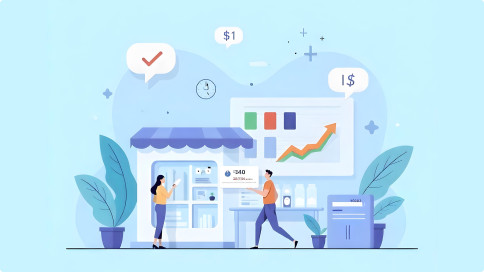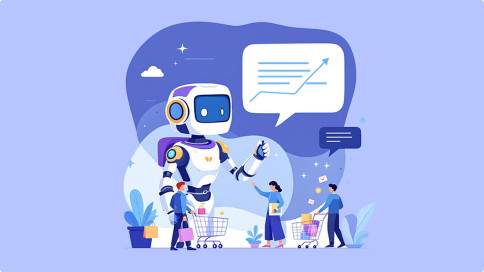The ROI of Chatbots: Measuring the Impact on Your Business

In today’s fast-paced digital landscape, businesses are constantly looking for ways to improve efficiency, reduce costs, and enhance customer experiences. Chatbots have emerged as a powerful tool to achieve these goals, but how do you measure their impact on your bottom line? Understanding the return on investment (ROI) of chatbots is crucial for businesses to justify their implementation and optimize their use.
In this blog, we’ll explore how chatbots deliver value, the key metrics to track, and how to calculate the ROI of chatbots for your business.
Why Chatbots Are a Smart Investment
Chatbots are more than just a trendy tech tool - they’re a strategic investment that can deliver tangible benefits across various aspects of your business. Here’s how:
- Cost Savings
Chatbots automate repetitive tasks, such as answering FAQs, processing orders, and handling basic customer inquiries. This reduces the need for large customer service teams, saving on labor costs.
- Increased Sales and Conversions
By engaging customers in real-time, chatbots can guide them through the buying process, recommend products, and even upsell or cross-sell, leading to higher revenue.
- Improved Customer Satisfaction
Chatbots provide instant, 24/7 support, reducing wait times and improving the overall customer experience. Happy customers are more likely to return and recommend your business.
- Enhanced Productivity
By handling routine tasks, chatbots free up your employees to focus on higher-value activities, such as resolving complex issues or driving innovation.
- Scalability
Chatbots can handle thousands of conversations simultaneously, making it easier to scale your operations without proportionally increasing costs.
Key Metrics to Measure Chatbot ROI
To calculate the ROI of chatbots, you need to track specific metrics that reflect their impact on your business. Here are the most important ones:
- Cost Savings
- Calculate the reduction in customer service costs by comparing the number of inquiries handled by chatbots versus human agents.
- Factor in savings from reduced training, infrastructure, and overhead costs.
- Revenue Growth
- Track sales generated directly through chatbot interactions, such as product recommendations or completed purchases.
- Measure the increase in average order value (AOV) due to upselling or cross-selling efforts.
- Customer Satisfaction
- Use metrics like Customer Satisfaction Score (CSAT) and Net Promoter Score (NPS) to gauge how chatbots impact customer happiness.
- Monitor chatbot-specific feedback to identify areas for improvement.
- Operational Efficiency
- Measure the time saved by automating tasks, such as responding to FAQs or processing orders.
- Track the number of inquiries resolved without human intervention.
- Engagement Rates
- Analyze how often customers interact with your chatbot and the average duration of conversations.
- Monitor the percentage of users who complete desired actions (e.g., making a purchase or signing up for a service).
How to Calculate Chatbot ROI
Calculating the ROI of chatbots involves comparing the benefits they deliver to the costs of operation and maintenance. Here’s a simple formula:
ROI = (Net Benefits / Total Costs) x 100
Step 1: Calculate Net Benefits
Net benefits include:
- Cost savings from reduced labor and operational expenses.
- Increased revenue from chatbot-driven sales and conversions.
- Improved customer retention and lifetime value.
Step 2: Determine Total Costs
Total costs include:
- Operating / subscription costs.
- Ongoing maintenance and updates.
- Integration with existing systems (e.g., CRM, e-commerce platforms).
Step 3: Plug the Numbers into the Formula
For example, if your chatbot generates $50,000 in net benefits and costs $10,000 to operate and maintain, the ROI would be:
ROI = ($50,000 / $10,000) x 100 = 500%
This means your chatbot delivers a 500% return on investment, making it a highly profitable tool for your business.
Real-World Examples of Chatbot ROI
E-commerce: A retail company implemented a chatbot to handle customer inquiries and recommend products. Within six months, the chatbot increased sales by 20% and reduced customer service costs by 30%.
Healthcare: A hospital used a chatbot to schedule appointments and answer patient questions. This reduced administrative workload by 40% and improved patient satisfaction scores by 15%.
Banking: A financial institution deployed a chatbot to assist with account inquiries and fraud detection. The chatbot saved US$1 million annually by reducing call center volume and improving fraud prevention.
Maximizing Your Chatbot ROI
To ensure your chatbot delivers the highest possible ROI, follow these best practices:
- Define Clear Goals: Identify specific objectives, such as reducing costs, increasing sales, or improving customer satisfaction.
- Choose the Right Platform: Select a chatbot solution that integrates seamlessly with your existing systems and scales with your business.
- Train Your Chatbot: Use AI and machine learning to continuously improve your chatbot’s accuracy and effectiveness.
- Monitor and Optimize: Regularly analyze performance metrics and make adjustments to enhance your chatbot’s functionality.
Conclusion
Chatbots are no longer a luxury—they’re a necessity for businesses looking to stay competitive in the digital age. By automating tasks, improving customer experiences, and driving revenue, chatbots deliver a significant ROI that can transform your business.
If you’re ready to harness the power of chatbots, now is the time to take the leap. Start by identifying your business goals, tracking the right metrics, and calculating the potential ROI. With the right strategy, chatbots can become one of your most valuable assets.



